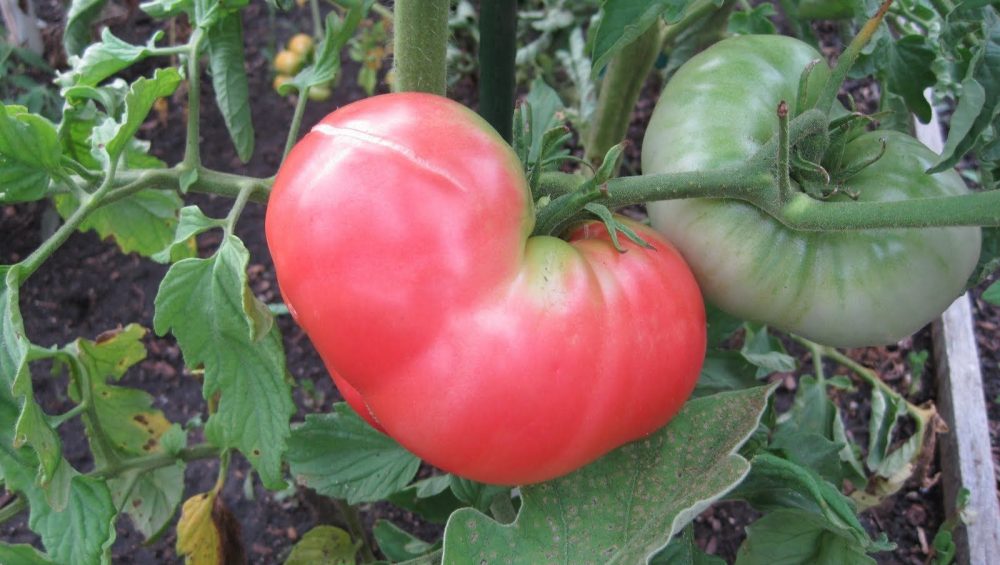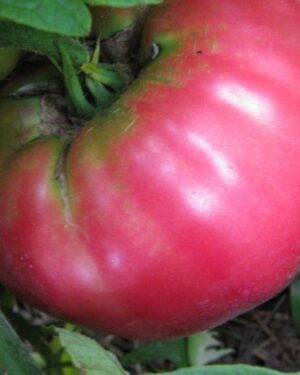Description
Tomato Ponderosa Pink new
Tomato Ponderosa Pink new. A heavy yielding, open pollinated tomato variety producing an abundance of large, flattish ½ to 1lb pink red meaty tomatoes in clusters of 3-5 fruits. The tomatoes themselves have a sweet and mild flavor with a thin skin and few seeds. This variety is susceptible to cracking if subject to irregular or over watering. Large vigorous vines. About 100 days to maturity. Indeterminate
Cultivation Advice
- Choose well-draining, fertile soil with a slightly acidic to neutral pH (6.0-7.0).
- Enhance soil fertility by incorporating organic matter like compost or well-rotted manure.
- Start Ponderosa Pink tomato seeds indoors 6-8 weeks before the last expected frost.
- Transplant seedlings into the garden after the danger of frost has passed, providing adequate spacing (24-36 inches apart).
- Ensure that the tomato plants receive full sunlight, at least 6-8 hours per day, for optimal growth and fruit development.
- Maintain consistent soil moisture throughout the growing season. Water deeply and regularly, especially during dry periods.
- Apply a layer of organic mulch around the base of the plants to retain soil moisture, suppress weeds, and regulate soil temperature.
- Provide sturdy support for the tomato plants, especially for indeterminate varieties like Ponderosa Pink, to prevent sprawling and breakage.
- Use a balanced, all-purpose fertilizer at planting and periodically throughout the growing season.
- Monitor plant health, and adjust fertilization based on the specific needs of the variety.
- Determine whether Ponderosa Pink is a determinate or indeterminate variety. Prune indeterminate varieties by removing suckers and lower foliage to improve air circulation.
- Regularly inspect for common tomato pests such as aphids, hornworms, or whiteflies.
- Utilize natural predators or implement organic pest control methods to address any infestations.
- Water at the base of the plant to minimize the risk of fungal diseases.
- Mulching can help prevent soil-borne diseases by reducing soil splashing onto the foliage.
- Harvest Ponderosa Pink tomatoes when they reach their full, mature color. This variety typically has large, pink-colored fruits.
- Plant tomatoes alongside compatible companions like basil, marigolds, or nasturtiums to enhance growth and deter pests.
- Ponderosa Pink tomatoes can be grown in large containers, making them suitable for patios or balconies. Ensure containers have proper drainage.
- Understand the growth habit of the Ponderosa Pink variety, as determinate types may not require as much pruning or support as indeterminate ones.
- Wait until the soil has warmed up before transplanting seedlings to ensure optimal growth.
- Harvest tomatoes by gently twisting them off the vine to avoid damaging the plant. Pick fruits when they reach their mature color for optimal flavor.
- Practice crop rotation to reduce the risk of soil-borne diseases. Avoid planting tomatoes in the same location every year.
- Install sturdy tomato cages around the plants early in the growing season to provide support as they mature.
- Implement organic pest control methods such as introducing beneficial insects or using neem oil to deter common tomato pests.
- In cooler climates, consider using season extension techniques like row covers to protect plants from late spring or early fall frost.
- Check if there are disease-resistant varieties of Ponderosa Pink available. Choosing resistant varieties can contribute to overall plant health.
- In late summer, consider light pruning to improve air circulation and sunlight penetration, especially if the plant has dense foliage.
- Use a moisture meter to monitor soil moisture levels and adjust watering practices accordingly to prevent overwatering or underwatering.
- Explore natural mulching alternatives like straw or shredded leaves to maintain soil moisture and regulate temperature.
- Periodically amend the soil with organic matter to replenish nutrients and improve soil structure.
- Keep a garden journal to record observations, including plant growth, flowering patterns, and any challenges faced, for future reference and improvement.











Reviews
There are no reviews yet.